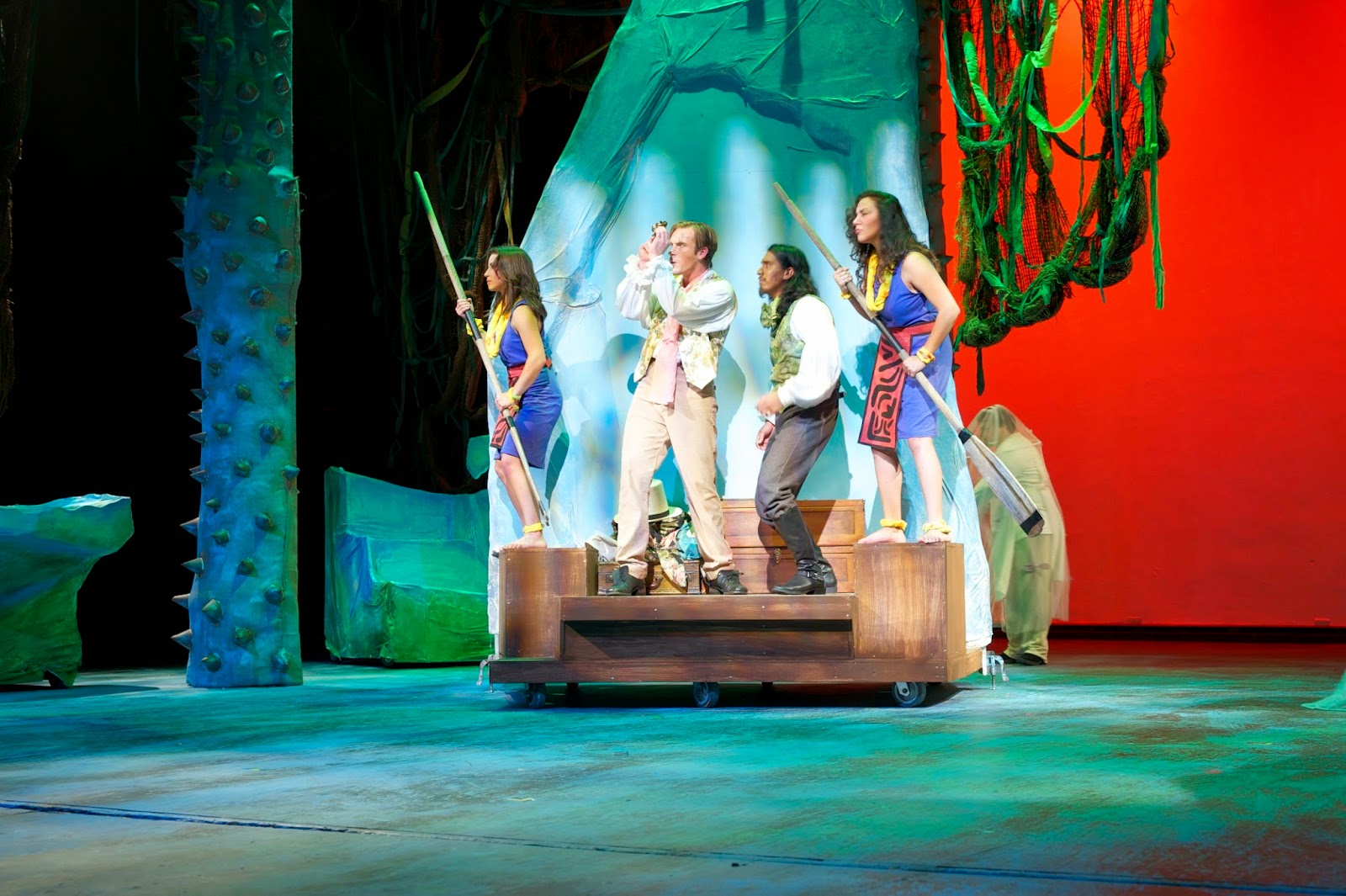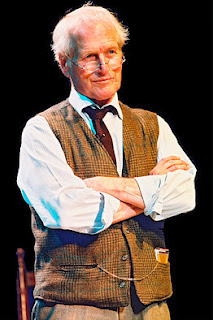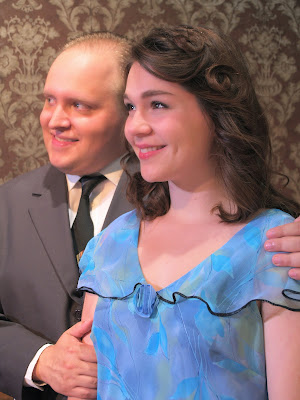Apart from the deeper meanings, it comes down to: Christmas R toys, right? And not just for children (or do I have to give back my Enterprise com badge and Doctor Who sonic screwdriver?) And what’s better than toys that come alive?
Among the many shows that play with this idea was Victor Herbert’s 1903 operetta
Babes in Toyland. It’s been reworked many times for stage, film and TV, and even though the original script in the Library of Congress reads like one of their own shows, Dell’Arte has reworked it again for their 2013 holiday production.
“We’re guided by the essentials of the Victor Herbert story,” said director Michael Fields. In the Dell’Arte version, the villainous Barnaby has taken over Toyland and is mass-producing terrible toys. The original Toymaster has disappeared. The various characters (including the Toymaster and a few Mother Goose figures) wind up in the Forgotten Forest, where people don’t remember who they are and have to figure it out. “It’s very funny, it has a happy ending,” Fields said, “ and there’s square-dancing.”
As always the Dell’Arte holiday show is made to travel, from its compact playing time to the set. “We have to create a visual world that supports the show, but with sets and lights that can be loaded in and out of a truck 17 or 18 times,” Fields noted. This year’s set, which transforms from various structures into the Forgotten Forest, is designed by Lynnie Horrigan, with lighting by Michael Foster and costumes by Lydia Foreman. Tim Gray composed the music and designed sound.
Cast members are Andrew Eldrege, Darci Fulcher, Billy Higgins, Ariel Lauryn, Allie Menzimer, Lucy Shelby, Jerome Yorke and Emily Newton.
“Some years we gone a little dark with our holiday shows,” Fields said. “But this year it’s very upbeat, energetic and bright to look at, with vivid costumes and a vibrant world. It’s in the genre of family theatre, which for me is a kind of European concept of theatre that isn’t just for children but is certainly family-friendly.”
Or as Fields summed up: “It’s fun. It’s free.” And yes, “certain toys come alive.”
Babes in Toyland opens at
Dell’Arte’s Carlo Theatre on Friday and Saturday, November 29 and 30 at 7:30 p.m., then tours up and down the North Coast before returning to the Carlo for the weekend of Dec. 19. All shows until final weekend are free. You can find the full schedule online at
dellarte.com, where there’s also ticket information for the various venues.
More on other versions...The script of the Victor Herbert original
Babes in Toyland at the Library of Congress (and
online here) satirizes consumer culture to a remarkable degree, including that new phenomenon, the department store. If thi
s is really the 1903 script (which it
may not be—it apparently changed several times), it seems consumerism (along with advertising, etc.) was already going strong at the turn of the 20th century. The earliest indictment of the consumer economy I’ve read is H.G. Wells trenchant novel
Tono-Bungay, first published in 1908.
As an ordinary part of their creative process, the Dell’Arte troupe researched available movie and TV versions, beginning with the 1934 Laurel & Hardy film. This is the only version I recall, renamed
March of the Wooden Soldiers, which I saw on TV a couple of times as a child. Although I was impatient with the singing, I was fascinated and excited by the life-size toy soldiers coming alive to defend the good guys.
“That movie was directly influenced by the film version of
The Wizard of Oz,” Michael Fields pointed out. It's not the first time. Apparently a lot was shared by the stage version of
The Wizard of Oz and Herbert’s
Babes in Toyland, which premiered the same year. Which show took from the other is an open question.
There was a 1961 Disney movie, and TV versions in 1986 and 1997, but before all of these there was a one hour version that was part of a series of dramatized fairy tales hosted by Shirley Temple. She had a series of specials in 1958-59 called
Shirley Temple’s Storybook that became a weekly series in 1960, The
Shirley Temple Show. It’s unclear whether this was broadcast earlier, but
officially Babes in Toyland was seen on December 25, 1960, on a Sunday evening opposite
Disneyland. It’s notable for being in color (a year before
Disneyland.)
Shirley Temple hosts it, surrounded by three of her own children, and talking slowly in that goody-goody voice that weirdly reflects her childhood persona. But she also acts and sings in the piece, as a heavily made-up ugly, evil witch. And she’s excellent.
It also stars Jonathan Winters as the evil Barnaby, comedians Jerry Colonna and Joe Besser (of late Three Stooges) and the young Danny Thomas-era Angela Cartwright. Like most versions after the first, the Toymaster is no longer a villain, but it does preserve some of the baddies with names straight out of
Othello, for some reason. There's one or two jokes about advertising but greed is mostly expressed in other ways. (The DVD suggests where the TV commercial breaks were.)
Of this version Fields said “It’s really fun and quite a good inspiration for us. You got the tail end of vaudeville with those comedians.”
Another annual family-friendly holiday show happens at the
Arcata Playhouse with a comedy at the center and different guest musicians for each performance. This year it’s
Bigfoot Lodge Holiday Jamboree, directed by Jackie Dandeneau. It features Amy Tetzlaff and Ryan Musil as refugees from Wisconsin who come to the North Coast with their strange ways to take over the Bigfoot Lodge, and Bob Wells as the resident Bigfoot expert. Meredith Anne Baldwin and real Wisconsinite David Ferney also perform, with live music by Tim Randles.
Set and lobby design is by local artists Lush Newton and Malia Penhall, with recycled holiday pieces from Scrap Humboldt. A shadow play by James Hildebrandt is also featured.
This year’s guest performances include the Arcata Interfaith Gospel Choir, Art Jones, Steven Weven, Trish Riel and pooch, Damiian Lange, Julie and Curtis Thompson, Shoshanna, and Pacific Union School Choir.
Beginning Dec. 5, Bigfoot Lodge Holiday Jamboree runs for two weekends at the
Arcata Playhouse, Thursday through Saturday evenings at 8 p.m., with a 2 p.m. matinee on Sunday Dec. 8. Tickets are available at Wildberries Marketplace or call (707) 822-1575. You can find more information including a schedule of guest appearances at
arcataplayhouse.org.
The Music Man by Meredith Wilson (script and songs) is the
Ferndale Repertory Theatre’s holiday show, though probably not because Wilson also wrote “It’s Beginning To Look A lot Like Christmas.” It’s a big, bright musical from Broadway’s Golden Age, with a love story, children, marching bands, a happy ending, and songs you sing on your way home.
It’s about a con man, and there’s nothing more American than that. Take the tricksters of folk tales around the world, add capitalism and the con man appears. “Con” stands for “confidence,” which is what the con man has to inspire to be successful. In this story as in many others, the con man is the city slicker who fools the country bumpkins (“clowns” were originally countryfied figures of ridicule.) This theme was clearer when there was a sharper distinction between urban and rural.
Directed by Dianne Zuleger, the cast of 30 is led by Jaison Chand as the con man Professor Harold Hill who comes to River City, and Caitlin McMurtry as his love interest, Marian the Librarian, and includes Gino Bloomberg, Greta Stockwell, Anders Carlson, Laura Rose and Tyler Egerer.
Linda Maxwell is choreographer, Elisabeth Harrington and Nanette Voss are vocal directors, Karen Kenfeld Fuller is costume coordinator, Bruce Keller scenic artist, with sound by Ian Schatz and lighting by Telfer Reynolds.
The Music Man opens at Ferndale Rep on Friday November 29, and plays Fridays and Saturdays at 8, Sundays at 2 through December 22, with Thursday night performances on Dec. 12 (benefit for cast and crew) and Dec. 19. For tickets call 707-786-5483 or on line at
ferndalerep.org
The original production of
The Music Man took forever to develop but once on Broadway in 1957 it ran forever. It became a national legacy with the 1962 technicolor movie. It was Robert Preston’s defining role, on stage and on screen.
On Broadway it was one of the last of the classic Golden Age musicals. The writing was on the wall with the show that was its greatest rival for the Tony that year:
West Side Story. The notoriously conservative award went to
The Music Man, but that’s not the judgment of history. It might even be said that one of the last and best of the classic musicals came up against one of the first and best modern musicals.
While “(Ya Got) Trouble” (“right here in River City”) and “Seventy-six Trombones” are probably the songs most associated with the show, the tuneful score also includes “Till There Was You,” most famously recorded by the Beatles in the early 60s. They didn’t know it came from
The Music Man, but Paul McCartney (who sang it solo) found out—and eventually bought the rights to all of Meredith Wilson’s songs. So it seems that some royalties will go from Ferndale right on over to Sir Paul. Merry Christmas to him, and to all, and good night.






































